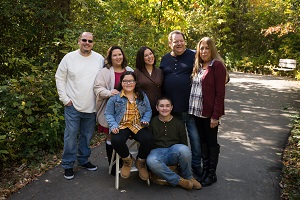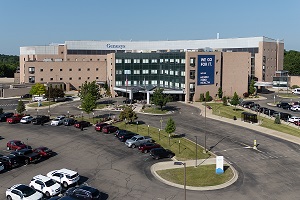Breakthrough in Heart Transplantation: Michigan’s First Beating-Heart Transplants

DETROIT--Ken Miller of Ferndale, Mich., woke up on his 58th birthday to extraordinary news: he was the recipient of the first beating-heart transplant in the state of Michigan, and one of few people in the country to ever undergo the surgery that promises better outcomes and more access to donor hearts.
In the groundbreaking medical procedure, the transplant team at Henry Ford Hospital, led by cardiac and transplant surgeon Dr. Kyle Miletic, successfully implanted Miller’s new heart while it was still beating. Dr. Miletic and the team completed another beating-heart transplant, believed to be the second in the state, less than three weeks later.
“I woke up on my 58th birthday to a new heart, a new kidney, and thanks to this team at Henry Ford, a new lease on life,” said Miller, who was a double organ recipient that day. “I think it’s simply a miracle.”
“Beating-heart transplant is novel. The first one was performed less than a year ago,” said Dr. Hassan Nemeh, Surgical Director of Thoracic Organ Transplant and Division Head of Cardiac Surgery at Henry Ford Health, who alongside Dr. Miletic, performed a second beating-heart transplant at Henry Ford Hospital in mid-June. “These two successful surgeries represent a significant advancement in organ transplantation for Henry Ford, the state, and the region, and it offers hope to so many patients awaiting life-saving procedures.”
Only about 70 beating-heart transplants have been performed in the United States to date.
Beating-heart transplants stand to solve a cardiac conundrum. Approximately 3,500 people in the United States currently await a heart transplant. The great demand for the gift of life has the medical world seeking novel approaches to organ transplant and transportation.
Traditionally, a heart is stopped, removed from the deceased donor, and transported on ice to the hospital where the transplant will occur. Donated organs placed on ice remain viable for a limited amount of time, thereby limiting the distance they can travel and, ultimately, the number of organs available for transplantation.
Technological advancements, sometimes referred to as “heart in a box,” allow viable organs to be transported from further away than traditionally possible, increasing the availability of donor organs. The technology keeps the heart pumping during transport.
“The heart in a box is like a mini heart and lung machine that we use for traditional open-heart surgery,” said Dr. Miletic. “Surgeons stop the heart at the donor hospital and put it on this machine. The machine restarts the heart and gives it all the blood and nutrients it needs to stay healthy, so while it’s traveling to Henry Ford Hospital, the heart never loses its blood supply and never stops beating until you take it off the device.”
While the machine allows for consistent blood flow, the heart stops twice—first during donation and again when it is removed from the machine for transplantation.
“Stopping the heart a second time weakens it, increasing the chances that the heart will need machine support—such as a balloon pump or ECMO—after transplant which can lead to longer recovery times for the patient,” Dr. Miletic explained. “But if the heart only has to stop once, the muscle remains stronger and outcomes for the patient are better.”
According to Dr. Miletic, in 20% to 30% of cases where the donor heart is stopped and restarted twice, patients’ recovery involves the support of a machine. Down the line, that may lead to complications such as strokes, kidney and liver damage. Avoiding that is likely to improve long-term outcomes and make the overall recovery process easier, Dr. Miletic said.
In this case, the team used the technique that allowed the heart to continue beating when they took it off the machine.
“While still on the device, we placed a tube in the donor heart and connected it to the bypass machine that the recipient was already on,” Dr. Miletic said. “This tube provided the recipient’s blood to the heart the entire time we were sewing it into the patient. Because the heart was getting blood flow, it kept beating the whole time we performed the procedure. While this was more challenging than operating on a still, stopped heart, the heart was much stronger and more robust than we typically see after the traditional method.”
Miller didn’t need any added support after surgery. He and his new heart are recovering well.
 “I live comfortably with my rescue dog, Chip, and I’m excited to go home and relax and get back to normal – to see my children and grandchildren, to sit and play my guitar again. I’m so grateful to these doctors to be able to say that,” Miller said.
“I live comfortably with my rescue dog, Chip, and I’m excited to go home and relax and get back to normal – to see my children and grandchildren, to sit and play my guitar again. I’m so grateful to these doctors to be able to say that,” Miller said.
By the time Miller’s double transplant surgery began on May 31, he’d been at Henry Ford Hospital for several weeks, receiving mechanical support for his failing heart from a balloon pump while awaiting a heart transplant. He’d been battling heart disease since 2013. Heart failure led to kidney failure, and the need for a kidney transplant, too.
The transplant team got word that a heart was headed to Detroit from several hundred miles away. Dr. Miletic identified Miller as a good candidate for a beating-heart transplant.
“It’s more challenging because you’re sewing in moving tissue, but this patient was exceptionally suited for this transplant method,” Miletic said. “Because this patient’s heart was so damaged over the years, it had grown to twice normal size, providing more space for us to operate. This was also his first surgery. When patients have previously undergone open-heart surgery, subsequent operations can be complicated due to the presence of scar tissue. In this case, conditions were near perfect for us.”
Dr. Miletic was assisted by his partner Dr. Dimitrious Apostolou, a specialist in cardiac surgery, and Dr. Rachel Diehl, a specialist in anesthesiology. Mary-Margaret Looby was the perfusionist, a highly skilled professional who runs the heart and lung machine during surgery and regulates and monitors blood flow to the donor heart during the implantation.
Miller, who suffered a heart attack in 2013, forcing him to retire from the dairy in Livonia where he worked for 30 years, said even when other physicians told him there was not much that could be done for him unless he received a new heart, he always held onto his faith that everything would be OK.
“I knew I’d need a new heart one day. I never dreamed it would be this special,” Miller said. His family has established a fundraiser through Help Hope Live to help cover medical bills.
In the second beating-heart transplant case performed at Henry Ford Hospital, the donor heart was transported from nearly 2,000 miles away and was outside the body for nearly seven hours due to travel time.
“Even though the box gives us more time to travel, it is not unlimited, and we have seen some issues with donor heart function when the heart is out of the body for so long,” Dr. Miletic said. “Therefore, I felt the additional protective effects of the beating heart technique were even more important for this patient.”
The donor heart worked well immediately, and the patient is recovering at Henry Ford Hospital.
“It takes a team with extensive experience and a spirit of innovation to make a groundbreaking procedure like beating-heart transplant go off without a hitch,” said Dr. Marwan Abouljoud, director of Henry Ford’s Transplant Institute. “The success speaks not only to the technological skills of our surgeons, but the strength of the team that makes Henry Ford’s leading-edge transplant program so successful.”
###
CLICK HERE FOR A DIGITAL MEDIA KIT
MEDIA CONTACT: mediarelations@hfhs.org
.svg?iar=0&hash=F6049510E33E4E6D8196C26CCC0A64A4)

/hfh-logo-main--white.svg?iar=0&hash=ED491CBFADFB7670FAE94559C98D7798)






